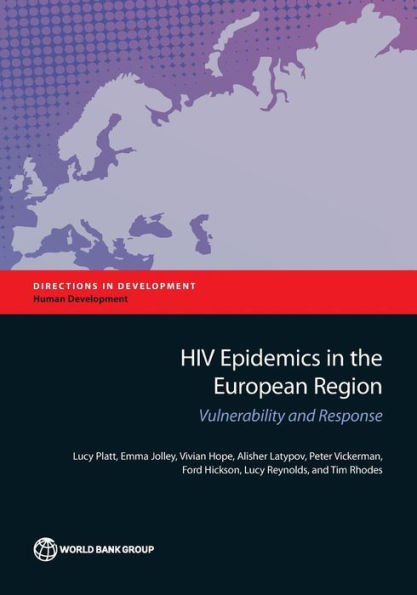
HIV Epidemics in the European Region: Vulnerability and Response
366
HIV Epidemics in the European Region: Vulnerability and Response
366Paperback
-
PICK UP IN STORECheck Availability at Nearby Stores
Available within 2 business hours
Related collections and offers
Overview

Product Details
| ISBN-13: | 9781464803888 |
|---|---|
| Publisher: | World Bank Publications |
| Publication date: | 01/27/2015 |
| Series: | Directions in Development |
| Pages: | 366 |
| Product dimensions: | 7.01(w) x 10.00(h) x 0.76(d) |
Table of Contents
Acknowledgments xiii
Executive Summary xv
Abbreviations xxxvii
Chapter 1 Introduction 1
Background 1
Methods 3
Notes 15
References 15
Chapter 2 HIV Surveillance 19
HIV Diagnoses and AIDS Case Reporting 19
Assessing HIV Prevalence and Risk Behavior 38
Note 51
References 51
Chapter 3 Epidemiology of HIV in Key Populations at High Risk 61
People Who Inject Drugs 61
Sex Workers 77
Men Who Have Sex with Men 97
Note 116
References 116
Chapter 4 Responses to HIV in Key Populations 143
HIV Surveillance Responses 143
HIV-Prevention Responses among People Who Inject Drugs 152
HIV Prevention Responses among SWs 171
HIV Prevention Responses among Men Who Have Sex with Men 183
Note 194
References 194
Chapter 5 Conclusion 213
The HIV Epidemics of Europe in Key Populations at High Risk 213
Intersecting Epidemics 215
Environmental Factors Shaping HIV Risk 217
Toward a Social Epidemiology of HIV Vulnerability 219
Strengthening HIV Surveillance 220
Strengthening HIV Prevention 221
A Shirt toward Social-Structural Intervention Approaches 227
References 228
Appendix A Systematic Review at Detailed Search Strategy 239
Appendix B Data Tables and Statistics 253
Appendix C Systematic Review and Summary Tables 277
Boxes
1.1 Definitions of HIV Epidemic 2
4.1 Four Core HIV-Prevention Interventions 152
4.2 Models of Regulation 176
A.1 Key Indicators of an Enabling Environment for PWID 248
Case Studies
2.1 Estimating HIV Prevalence among PWID in St. Petersburg, the Russian Federation 41
2.2 Estimating HIV Prevalence among PWID in Riga, Latvia 42
2.3 Two Decades of Scrobehavioral Monitoring of Infections among PWID in the United Kingdom 44
2.4 Serobehavioral Monitoring of Infections among FSWs in Kazakhstan 45
2.5 Estimating HIV Prevalence in the Kyrgyz Republic and Tajikistan 48
2.6 Using Biobehavioral Surveys to Measure HIV Incidence among PWID in Estonia 49
3.1 Stimulant Injection and HIV Risk in Europe 66
3.2 Sex Work and Drug Use 79
3.3 Central Asian Republics 85
4.1 Use of HPV Case Reports to Detect Outbreaks 146
4.2 The HIV-Prevention Impact of Introducing OST in the Russian Federation 153
4.3 Evidence of Commitment to HIV Prevention 166
4.4 Contact with Criminal Justice Systems in Central Asia 168
4.5 Trends Toward an Enabling Environment: Portugal 169
4.6 Sex Worker Services in Eastern Europe 172
4.7 The Importance of Location and Orgjnization of Sex Work in Facilitating Safer Sex Work: Examples from Tallinn and Moscow 175
4.8 Intervention to Reduce Violence 182
4.9 Measuring Coverage of Interventions for MSM 189
4.10 The Impact of Homophobic Polices in the Russian Federation 193
Figures
1.1 Comparison of HIV Prevalence and Incidence Projections in Three Sites in Eastern Europe (1996-2020) 12
2.1 Cumulative Total of Major Exposure Categories among All HIV Cases in Europe by Subregion since the Early 1980s 24
2.2 HIV Case Reports in Europe and Proportions by Subregion (2006-10) 25
2.3 Proportion of HIV Case Reports among Women, by Age and by European Subregion (2006-10) 26
2.4 HIV Case Reports and Proportion Associated with Injecting Drug Use (2006-10) 27
2.5 Cumulative HIV Case Reports in Europe Attributed to Injecting Drug Use, by Age and Subregion (2006-10) 28
2.6 HIV Case Reports and Proportion Attributed to Heterosexual Exposure (2006-10) 29
2.7 HIV Case Reports in Europe Attributed to Heterosexual Sex among Women and by Age (2006-10) 30
2.8 HIV Case Reports in Europe and Proportion Attributed to MSM (2006-10) 31
2.9 Proportion of HIV Diagnoses in Europe Attributed to MSM 30 Years Old or Less (2006-10) 33
2.10 Major Exposure Category among Cumulative HIV Case Reports in Europe (2006-10) 34
2.11 Exposure Categories among HIV Case Reports in the United Kingdom 35
2.12 Exposure Categories among HIV Case Reports in Ukraine (1995-2010) 36
2.13 HIV Case Reports and Heterosexual Exposure among Females: United Kingdom and Ukraine (2006-13) 36
2.14 Exposure Categories among HIV Case Reports in Tajikistan (2000-10) 37
2.15 Exposure Categories among HIV Case Reports in Estonia (1995-2010) 38
3.1 Best Estimates of HIV Prevalence among PWID in Eastern Europe 70
